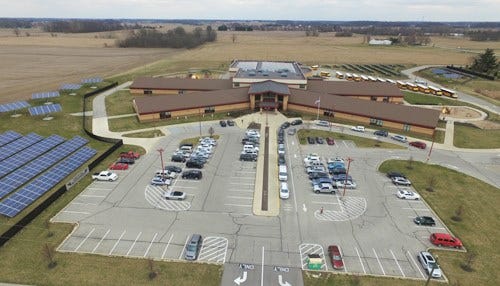Solar School System Sets Example

Subscriber Benefit
As a subscriber you can listen to articles at work, in the car, or while you work out. Subscribe NowThe Sheridan Community Schools system in Hamilton County is in just its first year of using solar energy as its sole power source, but administrators say they’re already seeing dividends in student engagement and community support.
A recommendation from an HVAC worker in 2015 led Sheridan school leaders to investigate savings that might be gained from a solar installation and, by the fall of 2016, all three schools were getting their power from the sun. Those same leaders say the switch was easy and smart, and that other Indiana schools should see if the sun is a good fit for them.
Sheridan Schools Superintendent Dr. Dave Mundy and Director of Business Robin Popejoy joke that the SCS solar project has gained so much attention, their talking points are now ingrained and they can finish each other’s sentences. But they agree the savings are no laughing matter.
“The project cost us about $4.3 million,” says Popejoy. “We didn’t bond it at all. We took out the amount of money we would have spent on utilities, and we’re using those funds to pay for solar instead of incurring debt. We set it up to break even over the 20 years of the loan. There’ll be years we’ll produce more energy, and others when we’ll need more, but the whole system is set up to be net-zero at the end of the 20 years.”
“It’s really helped us knowing that that’s going to be a consistent utility bill from now until 2037,” explains Mundy. “It allows us to move more money toward the classroom. This is a perfect example of what the state’s been requesting of us, in terms of wanting to see more money in the classroom. Solar allows us to do that.”
Mundy says SCS used every piece of available ground at its schools to put in solar arrays without impacting areas already in use. Johnson-Melloh installed the 1.8 MW system in just four months, and now instructors from the elementary to high school grades use it as a teaching tool.
“They have it sitting right outside their windows, so anywhere from math activities to writing activities have been incorporating solar. We have a computer program on TV monitors in the buildings that continually runs our output. Our kids can see to the minute how we’re processing energy for the day,” Mundy adds.
The solar array at the combined high school and middle school is standard, a series of rows with fixed panels. But Mundy says a lack of available land around the elementary school required an inventive design from Johnson-Melloh that uses three different types of collectors: standard panels, tracking panels that follow the sun throughout the day, and rooftop panels on the gym.
Mundy describes the project as being a good fit for SCS in three ways.
“Fiscally, it allowed us to use our own money in a responsible way. Academically, we now have a project in play that teaches our kids about renewable energy, saving money and planning for the future. And environmentally, we’re a small farming community, and it was on our shoulders to make sure we’re doing what we can to save the environment, so our community supported us was well.”
Mundy says he receives frequent feedback from community members happy about the project and concerned about proposed legislation that could change how Hoosier solar generators are reimbursed for the energy they produce.
Still, Mundy and Popejoy say they spend a lot of time fielding questions and speaking to other Indiana school administrators interested in following Sheridan’s solar path. They understand that the funding route they took might not work in all communities, but insist the payoffs make it worth investigating.
“It works well for almost any school,” says Mundy. “You could go the bond route or take out a loan, but because of net metering, you can do it with your existing funds. I think that’s why you’re seeing such a trend in schools using solar.”
